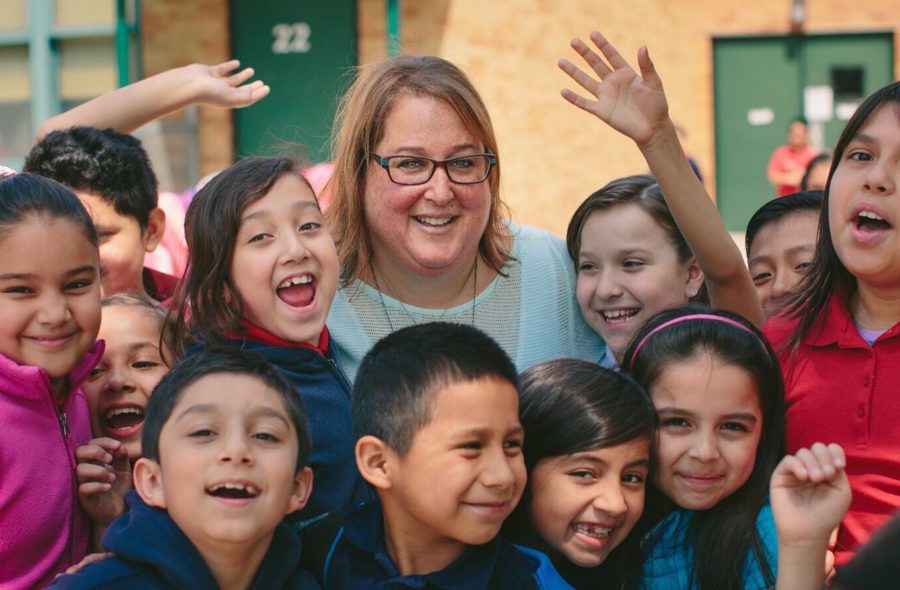Why my Chicago school got rid of all textbooks
July 12, 2018
As personalized learning takes hold throughout the city, Chicago teachers are wondering why a term so appealing has drawn so much criticism.
Until a few years ago, the school that I lead, Richard H. Lee Elementary on the Southwest Side, was on a path toward failing far too many of our students. We crafted curriculum and identified interventions to address gaps in achievement and the shifting sands of accountability. Our teachers were hardworking and committed. But our work seemed woefully disconnected from the demands we knew our students would face once they made the leap to postsecondary education.
We worried that our students were ill-equipped for today’s world of work and tomorrow’s jobs. Yet, we taught using the same model through which we’d been taught: textbook-based direct instruction.
How could we expect our learners to apply new knowledge to evolving facts, without creating opportunities for exploration? Where would they learn to chart their own paths, if we didn’t allow for agency at school? Why should our students engage with content that was disconnected from their experiences, values, and community?
We’ve read articles about a debate over personalized learning centered on Silicon Valley’s “takeover” of our schools. We hear that Trojan Horse technologies are coming for our jobs. But in our school, personalized learning has meant developing lessons informed by the cultural heritage and interests of our students. It has meant providing opportunities to pursue independent projects, and differentiating curriculum, instruction, and assessment to enable our students to progress at their own pace. It has reflected a paradigm shift that is bottom-up and teacher led.
And in a move that might have once seemed incomprehensible, it has meant getting rid of textbooks altogether. We’re not alone.
We are among hundreds of Chicago educators who would welcome critics to visit one of the 120 city schools implementing new models for learning – with and without technology. Because, as it turns out, Chicago is fast becoming a hub for personalized learning. And, it is no coincidence that our academic growth rates are also among the highest in the nation.
Before personalized learning, we designed our classrooms around the educator. Decisions were
made based on how educators preferred to teach, where they wanted students to sit, and what subjects they wanted to cover.
Personalized learning looks different in every classroom, but the common thread is that we now make decisions looking at the student. We ask them how they learn best and what subjects strike their passions. We use small group instruction and individual coaching sessions to provide each student with lesson plans tailored to their needs and strengths. We’re reimagining how we use physical space, and the layout of our classrooms. We worry less about students talking with their friends; instead, we ask whether collaboration and socialization will help them learn.
Our emphasis on growth shows in the way students approach each school day. I have, for example, developed a mentorship relationship with one of our middle school students who, despite being diligent and bright, always ended the year with average grades. Last year, when she entered our personalized learning program for eighth grade, I saw her outlook change. She was determined to finish the year with all As.
More than that, she was determined to show that she could master anything her teachers put in front of her. She started coming to me with graded assignments. We’d talk about where she could improve and what skills she should focus on. She was pragmatic about challenges and so proud of her successes. At the end of the year she finished with straight As—and she still wanted more. She wanted to get A-pluses next year. Her outlook had changed from one of complacence to one oriented towards growth.
Rather than undermining the potential of great teachers, personalized learning is creating opportunities for collaboration as teachers band together to leverage team-teaching and capitalize on their strengths and passions. For some classrooms, this means offering units and lessons based on the interests and backgrounds of the class. For a couple of classrooms, it meant literally knocking down walls to combine classes from multiple grade-levels into a single room that offers each student maximum choice over how they learn. For every classroom, it means allowing students to work at their own pace, because teaching to the middle will always fail to push some while leaving others behind.
For many teachers, this change sounded daunting at first. For years, I watched one of my teachers – a woman who thrives off of structure and runs a tight ship – become less and less engaged in her profession. By the time we made the switch to personalized learning, I thought she might be done. We were both worried about whether she would be able to adjust to the flexibility of the new model. But she devised a way to maintain order in her classroom while still providing autonomy. She’s found that trusting students with the responsibility to be engaged and efficient is both more effective and far more rewarding than trying to force them into their roles. She now says that she would never go back to the traditional classroom structure, and has rediscovered her love for teaching. The difference is night and day.
The biggest change, though, is in the relationships between students and teachers. Gone is the traditional, authority-to-subordinate dynamic; instead, students see their teachers as mentors with whom they have a unique and individual connection, separate from the rest of the class. Students are actively involved in designing their learning plans, and are constantly challenged to articulate the skills they want to build and the steps that they must take to get there. They look up to their teachers, they respect their teachers, and, perhaps most important, they know their teachers respect them.
Along the way, we’ve found that students respond favorably when adults treat them as individuals. When teachers make important decisions for them, they see learning as a passive exercise. But, when you make it clear that their needs and opinions will shape each school day, they become invested in the outcome.
As our students take ownership over their learning, they earn autonomy, which means they know their teachers trust them. They see growth as the goal, so they no longer finish assignments just to be done; they finish assignments to get better. And it shows in their attendance rates – and test scores.
Lisa Epstein is the principal of Richard H. Lee Elementary School, a public school in Chicago’s West Lawn neighborhood serving 760 students from pre-kindergarten through eighth grade.
Chalkbeat is a nonprofit news site covering educational change in public schools.
Originally posted on Chalkbeat by Lisa Epstein on July 12, 2018
This is the first in what we hope will be a tradition of thoughtful opinion pieces—of all viewpoints—published by Chalkbeat Chicago. Have an idea? Send it to [email protected]


















